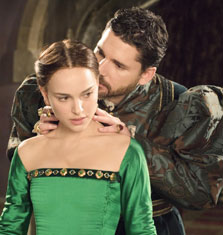Her Name Echoes Through History

 Anne Boleyn is most certainly one of history’s most famous people. Of course her name echoes through history; she was a magnetic, charming and intelligent woman centuries ahead of her time. Her life and death changed the world as we know it. Absolutely amazing how a woman, less than a person in those times, could change history and inspire so many people to love her and be fascinated with her even centuries after her death!
Anne Boleyn is most certainly one of history’s most famous people. Of course her name echoes through history; she was a magnetic, charming and intelligent woman centuries ahead of her time. Her life and death changed the world as we know it. Absolutely amazing how a woman, less than a person in those times, could change history and inspire so many people to love her and be fascinated with her even centuries after her death!
One crucial point that a person must remember is that in the times of the Tudors, women were seen as objects, too weak to be of any real use other than to bear sons, and too dumb to care. If a man had no ox, horse or other animal to plough his fields, he would expect his wife to carry the yoke and plough the field as if she were a beast1. Anne Boleyn showed the world that women are humans and hold as much power and fault as any man, most notably when she became Marquess of Pembroke. Not Marchioness, but Marquess, the title held only by men up until that point. A title she held in her own right, to be passed down to her descendants.
King Henry VIII was married to Queen Catherine of Aragon when he met and fell in love with Anne Boleyn, and unlike today, divorce was unheard of. However, Anne’s charm, wit, beauty, intelligence, and most importantly in Henry’s eyes, her youth and fertility, spurred him on to change the world. He knew he would never have a son and heir from Catherine of Aragon, but Anne could change that. With her young age and health, he could not only have a son off of her, but a nursery full of princes! Henry’s obsession with having a male heir, his unquenchable desire for Anne and his overwhelming love for her made history. I have every belief that Anne was in love with Henry at this point as well, and wanted to be his wife and therefore encouraged him to secure a divorce. She was, in effect, the neck that turned the head the way she wanted2.
Anne and Henry made a number of changes to Catholicism, creating a new religion branching off of Catholicism, thereby planting the seeds for Protestantism. The most obvious change was that divorce was made legal. The Bible, originally made only in Latin so only educated people could read it, was printed in English, so any person who could read, could learn the word of God. The bread and wine at communion was a representation of the body and blood of Christ, not His actual body and blood. A woman, who in those times was only a pawn for marriage and sons, was the second partner in changing the religion of Europe, the commanding force of the world.
However, Anne, obviously without the intention, had created a monster4. By convincing him that as king, he is God’s voice on Earth, and therefore Henry’s desires are God’s desires, she had given him complete control. Henry had no one to answer to, the Pope- far away in Italy- had no say in England’s matters. There was no Cardinal to guide Henry’s decisions, or to be the voice of his conscience. When Anne had suffered through two miscarriages, the second being the loss of the King’s son, Henry took it into his obsessed mind that Anne was a witch who had cast a spell upon him. Making up as many lies and falsehoods as it took to bring down his once love and treasure Anne Boleyn, he stripped her of her titles, wealth and freedom. The day after Mayday, May 2nd 1536, when all the world was blossoming and sunshine was filling the lives and hearts of the people of England, Queen Anne was taken to the Tower of London as a prisoner, “to be tried for incest, adultery and treason”4. On May 19th 1536, Anne Boleyn was executed by beheading on Tower Green, the first Queen Consort to ever be executed in history.
Anne’s legacy lived on after her death. The religion she helped found is still followed by many people today, her charm and mystery still inspire men and women alike to fall in love with her. Most importantly, the “useless” daughter she bore Henry became Queen Elizabeth I, a woman who led England to a Golden Age.
By Catharine Hamze